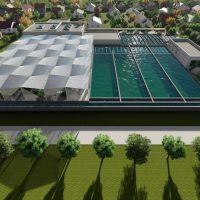How does the Organica FCR compare to other solutions?
How is the Organica solution different from the conventional activated sludge approach?
Organica FCR is a type of an integrated fixed-film activated sludge system offering substantial benefits, both technical and economic, over alternative solutions. Like all fixed-film systems, Organica FCR is based on the same activated sludge process that has been used in wastewater treatment for nearly a century, whereby micro-organisms and bacteria (collectively referred to as biomass) consume and metabolize or oxidize the contaminants available in wastewater.
Organica FCR drastically improves this process by leveraging a fixed-bed biofilm (attached growth, and not floating suspended in the water) that grows on both natural (plant) and engineered (patented biofiber media) root structures in a cascading reactor design, allowing a much greater quantity and diversity of organisms to thrive in the same physical space.
The larger and more diverse biomass per unit of reactor volume results in a significantly smaller physical footprint (reducing construction costs), as well as improved stability, increased nutrient removal performance, and reduced energy consumption.
Each Organica FCR is housed in an aesthetically-pleasing, odorless structure (greenhouse in colder climates, simple shading structures only in tropical climates) with the appearance of a botanical garden, preserving the surrounding land value and allowing the wastewater treatment plant (WWTP) to be placed directly adjacent to the wastewater source, thereby greatly reducing infrastructure costs.
How does the land requirement of an Organica facility compare to that of a traditional treatment system?
The combination of smaller reactor volumes, lower suspended solids, and creative architectural design results in land requirements up to 60% less than an activated sludge design for the same application. The smaller physical footprint results in significant land savings and reduced construction costs compared to alternative approaches
What are the cordon sanitaire requirements?
Buffer zone requirements depends on the local regulations, however thanks to the odor-free and noiseless operation, in addition to the aesthetically appealing image of FCR designs, regulators often break down the cordon sanitaire to 50 meters or less.
Are Organica facilities smaller than alternative processes?
The combination of smaller reactor volumes, lower suspended solids, and creative architectural design results in land requirements up to 60% less than activated sludge designs for the same application. The smaller space requirement results in less land usage and reduced construction costs compared to alternative approaches.
What are the operational costs?
The overall operating cost (OPEX) of an Organica FCR is significantly less than other activated sludge-based systems, primarily due to reductions in both energy demand and sludge production.
Because of the solution relies on fixed-film cultures, and less on cultures suspended in the water, the water in the reactor has lower solids concentration and is “clearer”. Oxygen transfer in clearer water is more efficient, thus less air is required to be pumped into the reactor to meet oxygen demand. This results in lower power consumption, typically 20 – 50% lower than competitive designs.
Further, due to the multilevel food chains that are present in complex ecosystems, the bacteria that process waste material are consumed by other organisms, which are in turn prey for higher predators within the food chain. This food chain effect results in lower excess sludge (commonly 20 – 30% less) at the end of the treatment process.
How much excess sludge (WAS) is produced?
The presence of plants and the cascading reactor design provides a habitat for distinctive self-regulating ecosystems, including many higher-level organisms. The resulting creation of a natural “food chain” results in up to 35% less excess sludge compared to other activated sludge-based solutions.
What is the average MLSS (mixed liquor suspended solids) concentration?
In the FCR reactors the biomass is fixed to the root structures, rather than suspended in water. We therefore use the term ‘Equivalent Biomass Concentration’ (EBC) rather than MLSS. The EBC for an Organica system is 10-18kg/m3. By comparison the MLSS in an Activated Sludge plant is 2-5 kg/m3.


